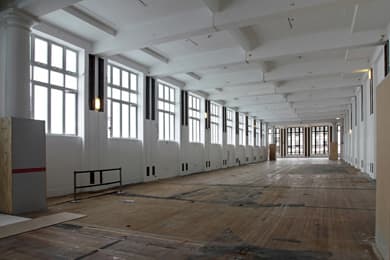Media Space, pictured before work began
The gallery – set to showcase a mixture of National Media Museum (NMM) exhibits – covering photography, film, television and the internet – is not now expected to open to the public until 21 September.
It will take over a 1,800m2 purpose-built area on the second floor of the Science Museum in South Kensington in London.
A spokesperson for Media Space – which had originally been due to open in the spring – told Amateur Photographer (AP) that the project manager, an external consultant, chose to leave the project, meaning that Media Space had to search for a new project management team.
‘By mutual agreement the original contract was terminated as an appropriate replacement was not available… This impacted on the capital build schedule,’ added the spokesperson.
A team from Fraser Randall were subsequently appointed as new project managers.
Media Space is the result of a tie-up between the Science Museum and the NMM in Bradford, West Yorkshire, which recently announced major cost cuts.
The spokesperson said that uncertainty surrounding the ongoing restructure at the NMM – which prompted a shift in certain job roles and a change in leadership there – has also played a part in the delay of Media Space.
However, she added: ‘No-one directly related to the delivery of Media Space has left the National Media Museum during the current review.’
In an earlier statement, Media Space said. ‘Taking into account contingency time for delays we felt that there was too short a time to realistically finish the build and install the first exhibitions in time for a June opening.’
Project bosses say they have the full £4 million funding in place, and expect to deliver Media Space ‘on budget’ in September.
Media Space had attracted an initial budget of nearly £9m, but that was before a £2.8m Heritage Lottery Fund bid was reportedly rejected in 2009.
Last year, AP revealed that more than half of the £4m needed would have to come from private sources, such as corporate sponsorship and donations from individuals.
Asked how much of the private funds have been raised, the Media Space spokesperson told AP: ‘I can confirm that over 50% of the funding for the Media Space capital project has come from private sources (which is over £2m).’
However, the delay has meant the postponement of an exhibition that was to showcase around 80 scientific photos from 1850-1920, plucked from the NMM’s and Science Museum’s historic collections.
The work of British photography inventor William Henry Fox Talbot was due to feature in the show, which was to be called ‘Revelations: Experiments in Photography’.
This exhibition is now expected to run at a later date, according to organisers who explained that a number of the works were loans from other institutions, but only for a limited period.
The first major exhibition at Media Space will now show photographs by Tony Ray-Jones.
Media Space chiefs say that Virgin Media, the gallery’s principal sponsor, continues its previously stated long-term commitment to the project following its recent sale to US cable TV company Liberty Global.
Last May, photographs donated by Michael G Wilson, co-producer of the James Bond films, were sold to help raise hundreds of thousands of pounds for Media Space.
Wilson, a well-known photographic collector, was among those to have donated photographs for an auction at Christie’s.
Last year, a further £47,000 was raised through the auction of a dinner jacket worn by Daniel Craig in the movie Skyfall.







